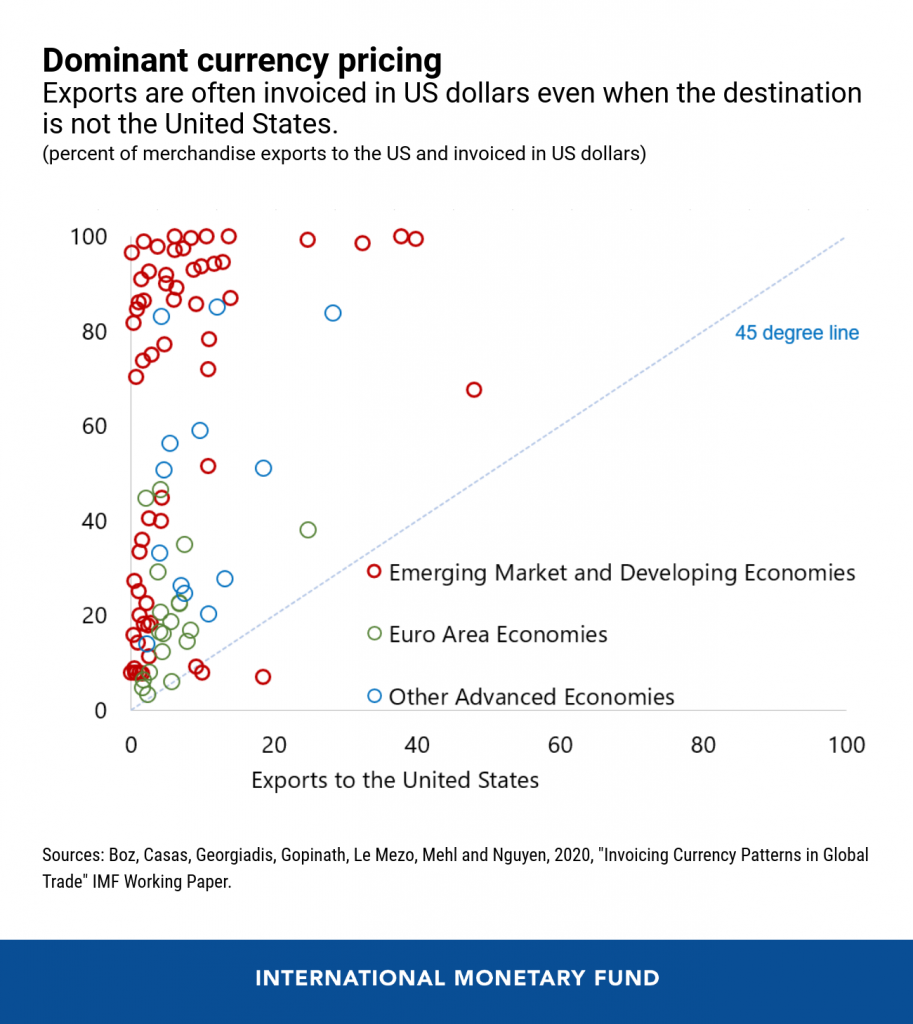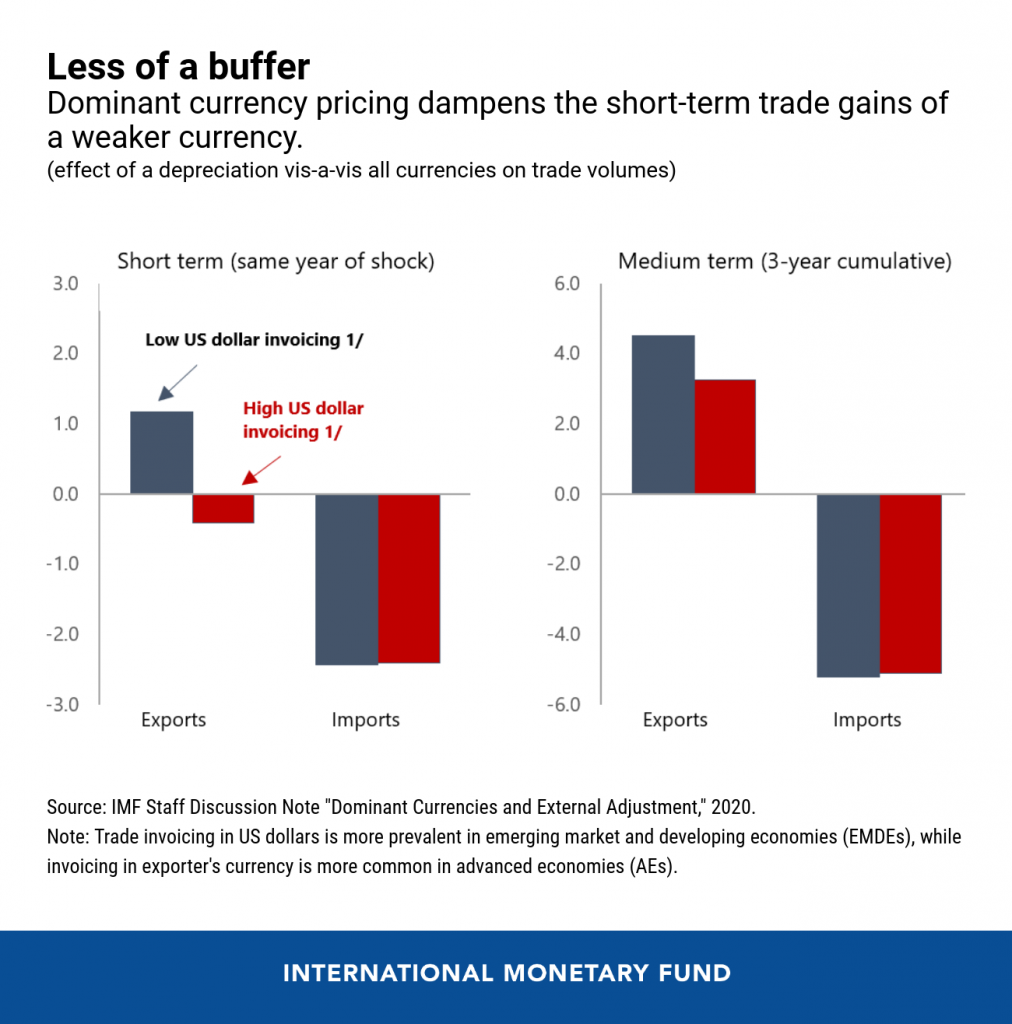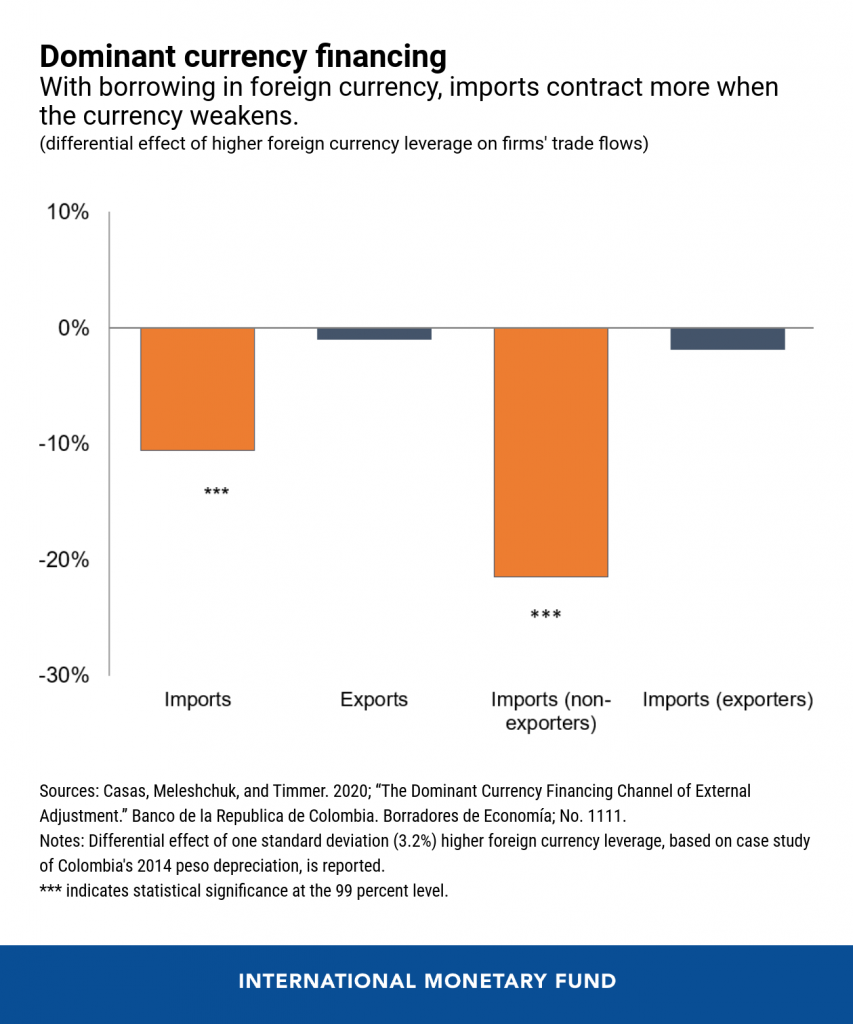Faced with an unprecedented shock of collapsing global demand and commodity prices, capital outflows, major supply chain disruptions and a generalized drop in global trade, many emerging markets and developing economies’ (EMDEs) currencies have weakened sharply. Will these currency movements support the recovery of these economies?
Building on a new dataset, research laid out in a new IMF Staff Discussion Note indicates that the short-term gains from weaker currencies may be limited. This is especially true for EMDEs where firms price their international sales and finance themselves in a few foreign currencies, notably the US dollar—so-called Dominant Currency Pricing and Dominant Currency Financing.
The prevalence of dominant currencies like the US dollar in firms’ pricing decisions alters how trade flows respond to exchange rates.
Dominant currency pricing
The central assumption underlying the traditional view on exchange rates is that firms set their prices in their home currencies. As a result, domestically-produced goods and services become cheaper for trading partners when the domestic currency weakens, leading to more demand from them and, thus, more exports. Similarly, when a country’s currency depreciates, imports become more expensive in home currency terms, inducing consumers to import less in favor of domestically-produced goods. Thus, if prices are set in the exporter’s currency, a weaker currency can help the domestic economy recover from a negative shock.
However, there is growing evidence that most of global trade is invoiced in a few currencies, most notably the US dollar—a feature dubbed Dominant Currency Pricing or Dominant Currency Paradigm. In fact, the share of US dollar trade invoicing across countries far exceeds their share of trade with the US. This is especially true in EMDEs and, given their growing role in the global economy, increasingly relevant for the international monetary system.
The inception of the euro initially reduced the dominance of the US dollar somewhat, but the latter has remained largely unabated since then. Other reserve currencies play a limited role. Dominant currency pricing is common both in goods and in services trade, although it is less prevalent in the latter—especially in some sectors, like tourism.
Another important implication of the use of the US dollar in trade pricing is that a global strengthening of the US dollar entails short-term contractionary effects on trade. This is because the weakening of other countries’ currencies vis-à-vis the US dollar leads to higher domestic currency prices of their imports, including from countries other than the US, and, thus, a lower demand for them.

Dominant currency financing
The prevalence of the US dollar is also a feature of corporate financing in EMDEs. This feature—Dominant Currency Financing—means that exchange rate fluctuations can also have effects through their impact on firms’ balance sheets, a phenomenon widely studied in the literature. A depreciation that increases the value of a firm’s liabilities relative to its revenues weakens its balance sheet and hinders access to new financing, as firms’ capacity to repay deteriorates. However, this effect depends on the currency in which revenues are earned, that is, whether revenues are in foreign currency or in local currency.
Exporting firms that use the US dollar or euros for both pricing and financing, are “naturally hedged” as liabilities and revenues move in tandem when exchange rates fluctuate. This means foreign currency financing is less of a concern when concentrated in exporting firms. Revenues and liabilities of importing firms, however, are typically not matched, and exchange rate fluctuations bring about balance sheet effects that constrain financing and import volumes. Dominant currency financing tends to amplify the effect of a country’s depreciation on its imports.
The prevalent use of the US dollar in corporate financing also means that a generalized strengthening of the US dollar can have globally contractionary effects through importing firms balance sheets.

Dominant Currencies and the Great Lockdown
Our analysis on dominant currencies suggests that the weakening of EMDE’s currencies is unlikely to provide a material boost to their economies in the short term as the response of most exports will be muted, besides the physical disruptions to trade from supply and demand disruptions. Meanwhile, key sectors that would normally respond more to exchange rates—like tourism—are likely to be impaired by COVID-related containment measures and consumer behavior changes.
Additionally, the global strengthening of the US dollar—which mainly reflects a flight to safe haven assets—is likely to amplify the short-term fall in global trade and economic activity, as both higher domestic prices of traded goods and services and negative balance sheet effects on importing firms, lead to lower import demand among countries other than the United States.
Exchange rates still have a role to play to contain capital outflow pressures and support the recovery over the medium term, but sustaining the domestic economy in the short term requires a decisive use of other policy levers, such as fiscal and monetary stimuli, including through unconventional tools.
You can watch the presentation here:






